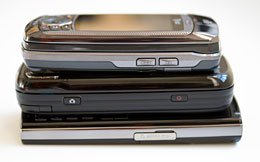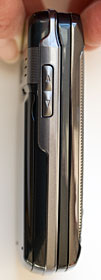|
Advertisement
|
Home -> Smartphone Reviews -> Pantech Duo C810
Pantech Duo
Editor's rating (1-5):   
Discuss this product
Review posted January 9, 2008 by Lisa Gade, Editor
in Chief
Editor's Note, Feb. 2009: Check out our review of the Pantech Matrix Pro, which replaces the Duo.
First impressions aren't always the best. When I first received the Pantech Duo, the small, plasticy device looked too. . . plasticy and I thought the worst. The lowly 1.3 megapixel camera, old-timey Bluetooth 1.2 and lack of GPS, a suddenly standard high-end amenity in AT&T smartphones, didn't help. In this country, Pantech mostly makes petite low end phones, and that also didn't help. But they did design the Helio Ocean, a dual-slider phone that's wow-d everyone (even us). Happily, the Duo owes more to the Ocean than phones like the C3 and C120 in terms of features and clever design. There's a hint of C3 only in the Duo's diminutive pre sense: this is one tiny Windows Mobile smartphone!
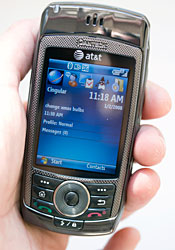
The Duo weighs just 3.88 ounces and measures 4.02 x 1.97 x 0.83 inches. This is the other "small" camp, where the phone is narrow, not terribly tall but not thin like the Samsung BlackJack II and Motorola Q Global. It's the PEBL in your pocket rather than the anorexic. If small makes you hot, it's simply a matter of determining which better matches your pants pockets. Personally, the thin but tall and wide phones don't fit my pockets as well as the Duo.
So what changed my mind about the Duo? Its triple threat of tiny design, dual slider keyboard (it has both a numeric and QWERTY keyboard that deploy when needed) and low price tag. At $99 with a 2 year AT&T contract, the Duo is a lot of phone. It's also faster than most Windows Mobile smartphones thanks to its 416MHz processor, a relative rarity among MS smartphones (but no so uncommon in Pocket PC phones).
Design and Ergonomics
The Duo is finished in a very shiny charcoal metallic plastic. A stippled surround wraps the display and front controls, a distinctly '70's touch no one in our office liked. Though the phone has a gloss surface it's not terribly slippery and the curvy shape that tapers at the bottom feels great in the hand. The phone by no means looks expensive but the build quality isn't bad; it doesn't creak, flex and the sliders are fairly solid with no more wobble than the ritzy Nokia N95 or AT&T 8525. The keyboards are spring located so they pop open easily with one hand and close just as surely. We've heard some reports of dust getting under the display but in the 3 weeks of heavy use our review unit received, including daily rides in linty pockets, we've seen nary a spec infiltrate.
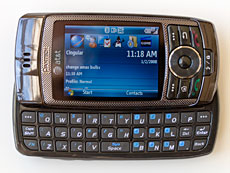
The Pantech Duo is the same thickness as the juggernaut AT&T Tilt. Simply, there's no way to make a skinny phone when there are two sliders involved. To make the device as thin as possible, the QWERTY keys did suffer: there's very, very little key travel and no doming. This makes for a less than ideal thumb typing experience, though we did like the width of the keyboard overall and the large keys. The keyboard is backlit and easy to read (letters are white and numbers and the Fn key are noted in light blue). Keys are generally where you'd expect them to be with the exception of the spacebar which has moved up from the desktop keyboard and sits in between the V and B keys on the bottom row. The minimal key travel and flat keys won't please heavy email and SMS users accustomed to the excellent BlackBerry, Treo and Motorola Q9 keyboard but it's fine for light texters, entering URLs and for anyone who's moving up from a numeric keypad phone. The phone's display automatically switches to landscape mode when you slide open the QWERTY keyboard and switches back when you close it. The display switching has less lag than most other Windows Mobile phones with similar QWERTY sliders.

The numeric keypad slider's keys are large, ever-so-slightly domed and have good travel: very nice. It's backlit in white and is easily viewable in the dark.
The SIM card lives under the battery beneath the back door and the microSD card slot is at the device's top edge. You'll need to slide open the number pad to gain full access to the fingernail-ridge under the slot's cover. The volume rockers are on the phone's upper left and are easy to operate when in a call. The camera and voice recorder/voice dialing button are on the right. The speakerphone grill and camera lens are on the smartphone's back. The phone's ergonomics are excellent overall-- it feels great in the hand and the controls are easy to reach but not overly easy to press accidentally. To prevent accidental button presses when in the pocket or purse, you can set the phone to lock shortly after the slider is closed and unlock when the slider is opened. Should a call come in when the controls are locked, you can still use the call send button to answer the call.
Phone Features, Reception and Data
The Pantech duo is a quad band GSM world phone that works on all GSM bands 850/900/1800/1900MHz. It's SIM locked to AT&T which means you must use an AT&T SIM with the phone (AT&T will provide an unlock code for customers in good standing with several months service history). The phone has EDGE as well as 3G data (HSDPA) on the two US bands (850/1900MHz) but not the Euro 2100MHz band. HSDPA speeds in the Dallas metroplex are very good and the phone averaged 780kbit/sec on DSL Reports mobile speed test. Like all WinMo 6 phones, the Duo has photo caller ID, speed dial, call history, vibrate, profiles and smart dialing (type in a few letters of a contact's name to bring up matches and dial).
|
|
Call quality is OK, incoming audio lacks great clarity but we never had a problem understanding our caller. Call volume is average by GSM standards, which is to say not terribly loud (get the Moto Q9 Global for super loud and clear audio). Call recipients said we sounded loud and clear, even when using the Duo with a variety of Bluetooth headsets. The speakerphone volume is average with little distortion at max volume. MS Voice Command 1.6 is included, and we applaud that. This is a powerful voice recognition system that requires no voice tag recording and works for dialing numbers along with commands to launch applications, hear your next appointment and more. Simply press and hold the record button on the phone's right side, wait for the tone and give a command to use Voice Command.
Size comparison: left photo- AT&T Tilt, Samsung BlackJack II and the Duo. Right photo, top to bottom: Duo, Tilt and BlackJack II
Like all Windows Mobile Smartphones, the Pantech Duo comes with mobile versions of Internet Explorer and Outlook (called Messaging). IE mobile does a reasonably good job of rendering full html web pages, though it can't compete with the desktop version or even the iPhone's web browser. It supports basic Javascript, SSL, frames but not multiple windows or tabbed browsing. Messaging handles POP3, IMAP and MS Exchange including MS Direct Push email (used in conjunction with Exchange Server 2003 SP2 or later). Page rendering speeds in IE were better than average, perhaps due to the faster CPU.
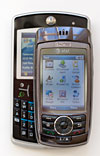
The Duo looks quite small onto top of the Moto Q9.
Horsepower and Performance
The Pantech Duo has a 416MHz Marvel Bulverde processor (formerly known as the Intel XScale Bulverde PXA27x before Intel sold their XScale business to Marvel). That's a very fast CPU for a Windows Mobile smartphone, and it's more commonly found in Pocket PCs and Pocket PC phones. The phone has a setting for turbo mode, which according to the manual allows the CPU to run at full speed for 5 seconds (we assume 5 seconds as needed at any time to launch an app or play video). The setting made little difference in performance or battery life. The Duo feels faster than most MS Smartphones running Windows Mobile 6, with less of the characteristic lag, even when switching between portrait and landscape models. For an entry level smartphone, we're surprised but pleased with the Duo's processor and speed.
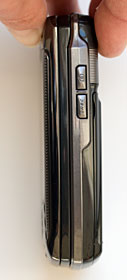 |
|
Sadly, the upgrade didn't carry over to the memory department. The Duo has a fairly standard 64 megs of RAM (used to run programs, just like RAM in your PC) and 128 megs of flash ROM for storing apps and data. Many of the most recent crop of Windows Mobile 6 phones have increased memory though, including the BlackJack II, Moto Q Global and AT&T Tilt. While flash memory, used for storage, is somewhat less important since you can use a microSD card to store programs and data, RAM is very important. Why? Because Windows Mobile doesn't exit programs, it just minimizes them. This means every program you launch continues to run in the background until memory gets so low that the OS starts killing running programs. This results in eventual slow downs or occasional quirky behavior. Thus we wish 128 megs was the standard for WinMo RAM. Since the OS itself requires memory to run, there are only 20 megs free just after boot, which means IE, Messaging and Media Player Mobile running together can use up most available memory. Of the 128 megs of flash memory, 55 megs are available to store programs and data. Should you need more space, especially for a music library, you can use microSD flash memory cards. Alas, the Duo doesn't support the newer higher capacity SDHC cards, so 2 gig cards are the limit. We tested the phone with a 4 gig card and it didn't see it at all.
Bluetooth
Bluetooth is stuck at 1.2 but the Duo does have A2DP for stereo playback through Bluetooth stereo headphones. The big drawbacks of Bluetooth 1.2 (most smartphones are at 2.0 now) is greater susceptibility to interference and slower data transfer speeds which seriously reduce the Duo's value as a wireless high speed modem for a notebook over Bluetooth. The Duo has all common profiles including headset, hands free, serial port, FTTP and the afore mentioned A2DP with AVRC for stereo playback control. We tested the Pantech with a variety of Bluetooth headsets and it worked well, though it was more prone to static interference and breakup than the Tilt, BlackBerry Curve and Moto Q Global when using smaller headsets (which have weaker transmitters). The Cardo S-800 sounded good on both ends, but we had to maintain line of sight between the headset and phone to avoid static on our end. The Jawbone sounded more muffled than usual with the Duo, and we suspect the phone's own DSP (a quite good one) and the Jawbone's together were overkill. The Plantronics Pulsar 590 stereo headset sounded great for stereo audio and outgoing voice but was tinny for incoming sound (it's incoming audio quality isn't wonderful in general though). Connections were reliable and automatic with all headsets and didn't drop out.
Multimedia and Camera
We haven't seen a camera this bad in years. The 1.3 megapixel camera takes murky photos with frequently wrong colors. It overexposes objects and people easily (no blazing sun required) and there's plenty of noise. The maximum photo resolution is 1280 x 1024 and there are 3 lesser resolutions suitable for things like caller ID (if you don't mind having purple or blotchy-white friends and associates in your caller ID photo list). Outdoor shots are sometimes decent under partly cloudy skies (too sunny and things white out). There are a variety of settings to control the camera, including image quality, white balance, effects and save location. Much of the display is used as the viewfinder with the upper section devotes to a selection of tiny icons indicating current settings and two sliders, one for digital zoom (up to 4x) and the other for brightness (press the d-pad right and left to adjust brightness and up/down to change zoom).
The Duo can shoot video with audio at 320 x 240 and 176 x 144 in MPEG4 format. Our 320 x 240 test video came out at 6 fps, with lots of motion blur and muffled audio. The phone beeps when recording begins, and this beep is captured in the video. It's about as impressive as the still camera. If the camera is important to you, this probably isn't your phone. The camera application times out and auto-exits after a minute of inactivity, which isn't handy if you're patiently waiting for the right moment to snap a shot. |

The wall is not pink, and generally doesn't appear as such when taken with other camera phones. |

Indoors on a mostly cloudy day, yet the poor kitten is whited-out. |

The best shot we got with the Duo- a mostly cloudy day led to good exposure with somewhat believable colors. |
Multimedia playback is more pleasing with the Duo providing better than average video playback among MS smartphones in our ripped video tests using MPEG and MPEG4 (AVI) files. Our 320 x 240 330 kbps WMV test movie played back smoothly with very few frame drops in Windows Media Player Mobile (we often see significant frame drops with MS Smartphones even at this fairly low bitrate). The Duo comes with all sorts of AT&T goodies including CV (Cellular Video, formerly known as Cingular Video), XM Radio and Music ID. The latter 2 require a monthly fee, but most streaming video content on CV is gratis with a data plan. Free content includes CNN, ESPN, The Weather Channel, Comedy Central and Fox Sports. Content plays through Windows Media Player Mobile and is streamed at less than QVGA resolution (you can stretch it full screen, though quality does degrade). AT&T also offers HBO mobile in the pay-for section of CV, and this runs $4.99/month. There are 4 shows currently running, and each is broken down into 5 minute segments (so you'll download 5 segments to watch a half hour episode of Curb Your Enthusiasm).
Software
In addition to the standard Windows Mobile 6 Standard application suite which includes mobile versions of IE, Outlook, Windows Media Player and MS Office (with read/ edit-only versions of Word, Excel and PowerPoint), AT&T and Pantech include a Java VM, ClearVue PDF viewer, World Time, the OZ IM client that handles AIM, Windows Live Messenger and Yahoo IM services. AT&T also includes their usual XPress Mail, AT&T Mall, MySpace Mobile, XM Radio (requires a monthly fee), MusicID and AT&T Music (Napster). MobiTV is pre-installed (a streaming TV service that that requires a monthly fee) as is MyCast Weather (trial). There's a link to get TeleNav Maps (but keep in mind, the phone doesn't have a GPS). The phone ships with ActiveSync 4.5 and a 60 day trial of Outlook 2007 for Windows. The phone doesn't come with sync software for any other platform, but Mac users can purchase Missing Sync to sync the phone to an OS X Mac (we tested it with a Mac Pro and it worked well).
Conclusion
Size matters and the Pantech Duo is seductively small, though not thin. It fit easily in our pockets and it's so light, we couldn't tell it was there. It makes the HTC S710 and SMT5800 (who share the QWERTY sideways slider design but not a keypad slider) look a tad big, and the Moto Q Global looks absolutely huge. The display is sharp and bright and all the Windows Mobile features are there and work well, making this a powerful little phone. Though it looks plasticy, the sliders are firm and wobble less than the just mentioned HTC phones and it survived the wilds of pocket, purse and a playful kitten with no harm done. For $99 with a contract after data plan rebate, the phone offers a lot, though the BlackBerry Curve and BlackJack II compete, and at the same price offer more. The Duo wins there only on size, especially for those who hate wide, tall QWERTY bar phones. It's nice to have the choice, thanks to AT&T's broad selection of PDA and smartphones.
Pro: A very small smartphone! Solid (durable, rigid plastics), fast processor and better than average speed, good display, great dual-slider design. Good HSDPA performance and reception with fast web page load times. CV performs well, as do other multimedia applications.
Con: Terrible camera, SD card slot doesn't support cards over 2 gigs in capacity, not classy looking.
Web sites: wireless.att.com, www.pantech.com
Price: $199, $99 after rebate with PDA data plan.
|
Display: 262K color transflective
color LCD with LED backlighting. Screen size diagonally: 2.2". Resolution:
240 x 320, supports both portrait and landscape modes.
Battery: Lithium
Ion rechargeable. Battery is user replaceable.
1320 mA.
Performance: XScale Marvel Bulverde 416 MHz processor. 64 MB built-in RAM
(20 megs free after boot). 128 MB Flash memory with 55 megs free.
Size: 4.02 x 1.97 x 0.83 inches. Weight: 3.88 ounces.
Phone: Quad band 850/900/1800/1900MHz GSM world phone with EDGE for data and dual band 850/1900MHz 3G HSDPA for the US.
Camera: 1.3MP with 4x digital zoom. 1280 x 1024 max resolution. Can take MPEG4 video at 320 x 240 and 176 x 144 resolutions.
Audio: Built
in speaker, mic and proprietary stereo headphone
jack (adapter dongle included to use 3.5mm headphones). Voice Recorder and Windows Pocket Media Player 10 included for your MP3 and video playback pleasure.
Networking: Integrated
Bluetooth 1.2. Headset, hands free, A2DP, AVRC, FTP, serial port and PAN profiles.
Software: Windows
Mobile 6.0 Standard Edition operating system.
Microsoft Mobile Office suite including Mobile versions
of Word, Excel, PowerPoint Internet
Explorer, and Outlook. Other standard apps include Windows Media Player
Mobile, Solitaire, Bubble Breaker, Voice Recorder. Additional applications: Java VM, ClearVue PDF viewer, World Time, MS Voice Command, TeleNav Maps, Task Manager, OZ IM client that handles AIM, Windows Live Messenger and Yahoo IM services. AT&T includes XPress Mail, AT&T Mall, XM Radio (requires a monthly fee), MusicID and AT&T Music (Napster). ActiveSync 4.5 and Outlook 2007 trial for PCs included.
Expansion: 1
microSD card slot (does not support SDHC).
|
|
|





